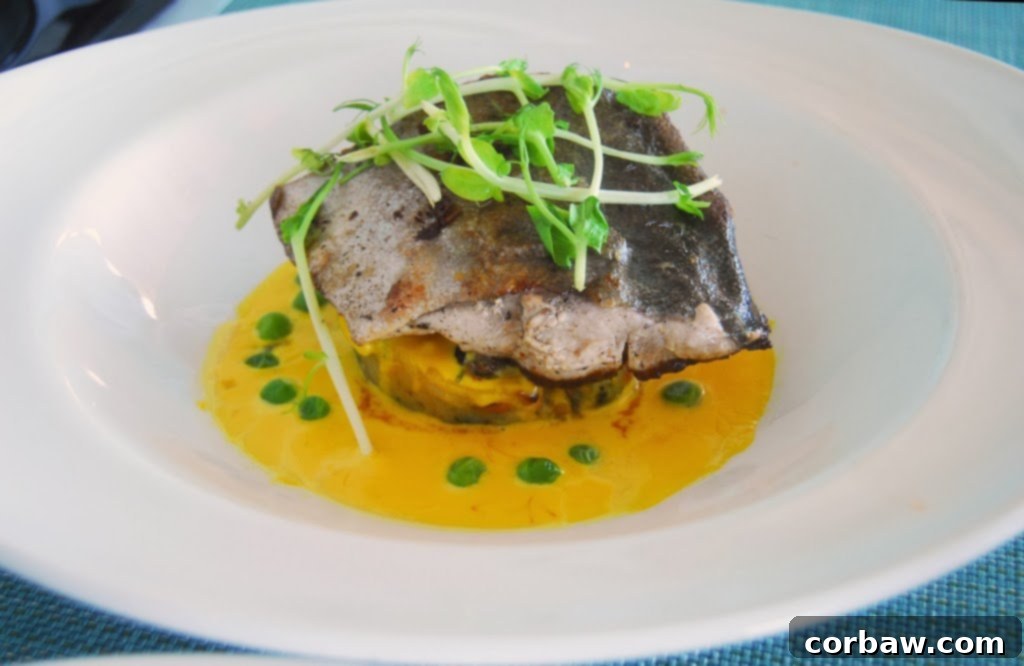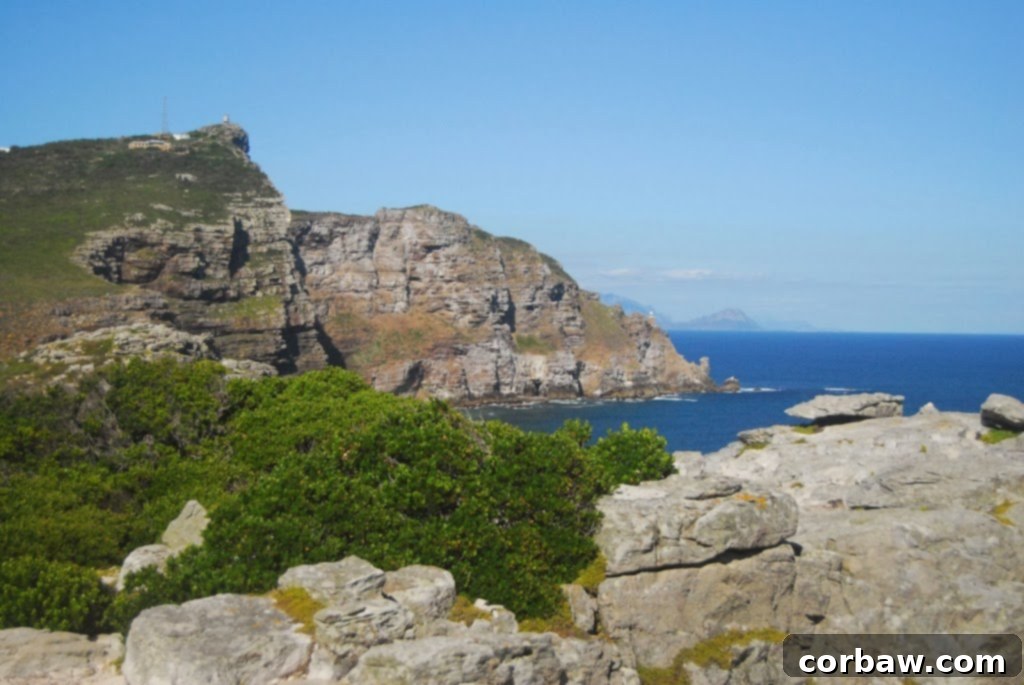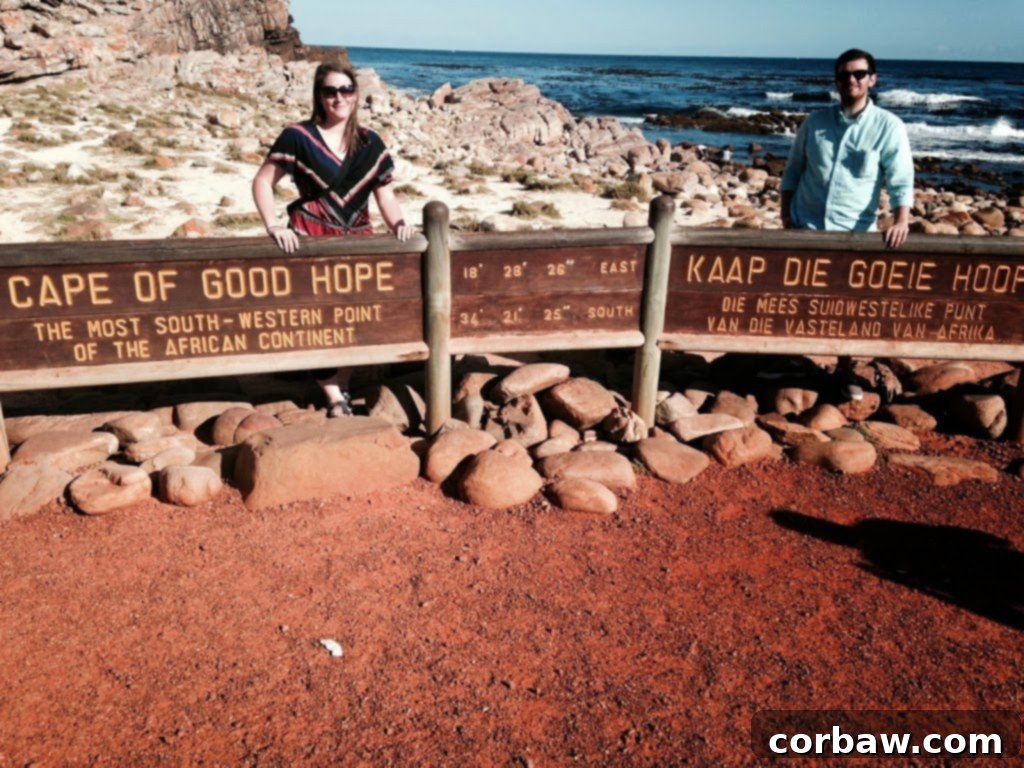Exploring the Iconic Cape of Good Hope: A Journey Through Table Mountain National Park, South Africa

Following an unforgettable encounter with the charming African penguins at Boulders Beach, my fiancé and I continued our scenic drive further down the picturesque cape, venturing deeper into the sprawling embrace of Table Mountain National Park. As we navigated the winding roads, we were met with a series of prominent warning signs, each emblazoned with a clear message: baboons. These signs served as constant, emphatic reminders of their presence and the critical importance of not feeding them. The message was well and truly ingrained in my mind; the idea of an up-close and personal interaction with a wild baboon seemed rather daunting, to say the least.
The first half of our day had been filled with exhilarating activities—chasing the playful antics of penguins and scaling ancient boulders by the sea. Naturally, as the midday sun climbed higher, my primary focus shifted to the delightful prospect of lunch. Our destination, strategically positioned at the very tip of the cape, was the exquisite Two Oceans Restaurant. This culinary gem boasts breathtaking views overlooking the expansive False Bay, offering a dining experience that is as visually stunning as it is gastronomically satisfying. We secured a table on the outdoor patio, allowing us to fully immerse ourselves in the panoramic vista of the bay, bask in the glorious sunshine, and enjoy the refreshing ocean breeze. It was, without exaggeration, an absolutely perfect setting for a midday meal.
Eager to explore the local flavors, we each decided to try a new-to-us fish from the menu. I opted for hake, pronounced “hay-ck,” a firm white fish, beautifully prepared with a vibrant salsa verde and accompanied by deliciously lemony roasted potatoes. The dish was a symphony of fresh flavors, perfectly capturing the essence of coastal dining.

My fiancé, equally adventurous, chose the line fish, served with a unique twist of mussel-infused potatoes. Both selections were outstanding, a testament to the restaurant’s commitment to fresh, locally sourced seafood and masterful preparation. The experience was more than just a meal; it was a moment of pure bliss, recharging our energy levels for the adventures that lay ahead.

With our appetites thoroughly satisfied and spirits lifted by the delicious food and stunning scenery, we embarked on the next leg of our journey: the trek out and up to the very pinnacle of the Cape of Good Hope. Before setting off, we passed several more signs, reiterating the now familiar warnings about not feeding the baboons. These magnificent primates, while fascinating to observe from a distance, are wild animals, and maintaining a respectful distance is crucial for both their safety and ours. Their intelligence and opportunistic nature mean they are always on the lookout for an easy meal, making it vital for visitors to keep all food securely stowed and car windows closed.

As we ascended, the landscape transformed. The vibrant fynbos vegetation, unique to this biome, painted the hillsides with a rich tapestry of greens and earthy tones, punctuated by bursts of colorful blooms. The air grew crisper, carrying the distinct scent of the ocean, and the panoramic views expanded with every step. The climb, while not overly strenuous, offered increasingly dramatic vistas, building anticipation for the moment we would reach the absolute tip. And when we finally stood there, looking out over the expansive, azure waters at the southwesternmost point of the African continent, it was an experience unlike any other. The sheer scale of the ocean, stretching endlessly towards the horizon, combined with the rugged beauty of the cliffs below, evoked a profound sense of awe. It’s a place where you truly feel the raw power and majesty of nature.

The historical significance of the Cape of Good Hope is as vast and deep as the ocean it oversees. For European sailors navigating the treacherous journey to Asia centuries ago, rounding the Cape was a monumental achievement and a critical geographical marker. Originally named the “Cape of Storms” by Portuguese explorer Bartholomew Dias in 1488 due to its notoriously perilous weather and rough seas, it was later renamed by King John II of Portugal to the “Cape of Good Hope” because of the immense optimism it brought for a new sea route to the East. This strategic point marked where a ship would begin to alter its course, moving more easterly than southerly, signifying the successful passage from the Atlantic into the Indian Ocean (though geographically, the true meeting point of the two oceans is at Cape Agulhas, the Cape of Good Hope holds a profound symbolic and historical importance as ‘the turn’). It was a beacon of progress and a testament to human endeavor in exploration.

Thankfully, our journey to the top was free of any close encounters with baboons, allowing us to fully appreciate the serene beauty of our surroundings. However, we did share the scenic pathways with a myriad of tiny, nimble lizards. These little reptiles, darting across rocks and disappearing into the low-lying fynbos, added an enchanting touch to the wild landscape. They are a common sight in the area, perfectly adapted to their environment, and fascinating to watch as they go about their day, basking in the sun or hunting for insects. Beyond these small creatures, Table Mountain National Park is a haven for diverse wildlife, including ostriches elegantly striding across open plains, various antelopes like the majestic eland, and the adorable dassies (rock hyraxes) sunning themselves on rocky outcrops. From the coastline, lucky visitors might even spot whales during migration season or playful dolphins year-round, adding another layer of natural wonder to this spectacular reserve.

After soaking in the magnificent views from the higher vantage point near the old lighthouse, we carefully made our way down to the famous Cape of Good Hope sign. This iconic landmark marks the official “southwesternmost point of the African continent” and is an absolute must for any visitor. Joining a small queue of fellow travelers, we patiently waited for our turn to capture that quintessential photo, a tangible memory of standing at such a globally significant location. The feeling of placing your hand on the sign, with the endless ocean stretching behind you, is incredibly satisfying – a true “I was here” moment that solidifies the experience.

As we began our drive back through the vast and stunning Table Mountain National Park, I found myself scanning the roadsides and distant hills with hopeful anticipation. Despite the numerous warnings, I was still keen to catch a glimpse of a baboon, albeit from the safety and comfort of our car. Unfortunately, no such luck on that particular journey. However, the memory of the majestic landscapes, the refreshing ocean air, the delicious seafood, and the profound historical echoes of the Cape of Good Hope will remain etched in our minds. This corner of South Africa truly offers an unparalleled blend of natural beauty, adventurous exploration, and rich historical narrative. It’s a testament to the power of travel to connect us with both the wild world and the annals of human endeavor. I remain optimistic that my chance to snap a photo of a baboon in its natural habitat will come soon enough on a future adventure!
